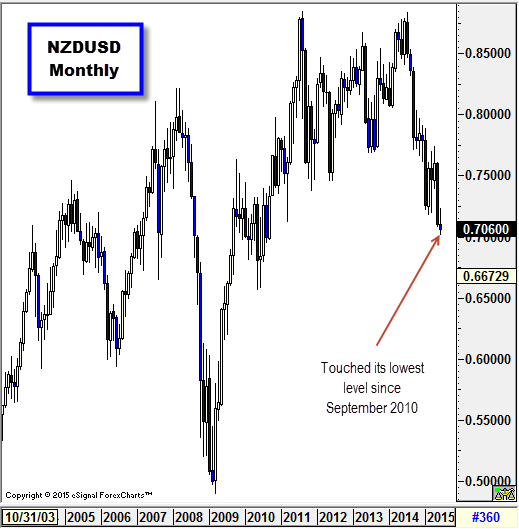Currencies | Jun 11 2015
By Chris Tedder, research analyst with Gain Capital
The Reserve Bank of New Zealand (RBNZ) cut interest rates for the first time in four years, lobbing 25 basis points off the official cash rate, citing low inflationary pressures and an expected weakening in demand. At the same time, the bank opened the door for even looser monetary policy later this year, with Governor Wheeler noting that further easing may be appropriate beyond today’s cut that brought the OCR to 3.25%, despite the threat of a property bubble in Auckland. Wheeler pointed out that the proposed LVR measures planned for October 2015 should ease investor activity in the property market.
The NZ dollar was mauled by bears following the bank’s decision to loosen monetary policy, with NZDUSD touching its lowest level in over 4.5 years. Meanwhile, the volatility in NZ dollar saw the biggest intraday move in AUDNZD since August 2013, with the pair gaining almost 2% at one stage as a slew of stops were wiped out between 1.0900 and 1.1000.
The volatility in the kiwi is due to the mixed expectations of the market prior to the meeting. Only around 50% of participants were expecting the RBNZ to loosen monetary policy, at least according to the interbank market. Furthermore, not only did the bank cut the OCR, it suggested that it may loosen policy even further in the foreseeable future and verbally assaulted the exchange rate once again. There’s no silver lining for the kiwi this time around, it’s all storm clouds.
The bank has been setting the stage for a cut for over a month now, ever since RBNZ Assistant Governor McDermott made some fairly dovish comments about the outlook for interest rates in NZ. McDermott stated that the RBNZ isn’t considering hiking interest rates at this stage and weaker demand and inflation would prompt rate-cut talk. The RBNZ reinforced his view at its policy meeting a few days later and has been working on macro-prudential tools to cool the housing market. This was the beginning of the end for the NZ dollar.
Outlook for NZDUSD
Yesterday’s announcement has clearly put the kiwi on the back foot, but it hasn’t mortally wounded NZDUSD; the pair remains above an all-important support zone around 0.7000. Above 0.7000 there’s some room for a technical retracement, but the fundamentals have now completely shifted to the downside for the NZD, at least in the near-term. A rebound in dairy prices, domestic economic activity and/or an even stronger than expected performance from Auckland’s housing market may be needed to save the kiwi.

Now you can follow us on Twitter: http://twitter.com/FOREXcom
Re-published with permission. Views expressed are not by association FNArena’s (see our disclaimer).
Disclaimer: The information and opinions in this report are for general information use only and are not intended as an offer or solicitation with respect to the purchase or sale of any currency or CFD contract. All opinions and information contained in this report are subject to change without notice. This report has been prepared without regard to the specific investment objectives, financial situation and needs of any particular recipient. Any references to historical price movements or levels is informational based on our analysis and we do not represent or warrant that any such movements or levels are likely to reoccur in the future. While the information contained herein was obtained from sources believed to be reliable, the author does not guarantee its accuracy or completeness, nor does the author assume any liability for any direct, indirect or consequential loss that may result from the reliance by any person upon any such information or opinions.
Futures, Options on Futures, Foreign Exchange and other leveraged products involves significant risk of loss and is not suitable for all investors. Increasing leverage increases risk. Spot Gold and Silver contracts are not subject to regulation under the U.S. Commodity Exchange Act. Contracts for Difference (CFDs) are not available for US residents. Before deciding to trade forex and commodity futures, you should carefully consider your financial objectives, level of experience and risk appetite. Any opinions, news, research, analyses, prices or other information contained herein is intended as general information about the subject matter covered and is provided with the understanding that FOREX.com is not rendering investment, legal, or tax advice. You should consult with appropriate counsel or other advisors on all investment, legal, or tax matters. FOREX.com is regulated by the Commodity Futures Trading Commission (CFTC) in the US, by the Financial Conduct Authority (FCA) in the UK, the Australian Securities and Investment Commission (ASIC) in Australia, and the Financial Services Agency (FSA) in Japan. Please read Characteristics and Risks of Standardized Options (http://www.optionsclearing.com/about/publications/character-risks.jsp).
Technical limitations
If you are reading this story through a third party distribution channel and you cannot see charts included, we apologise, but technical limitations are to blame.
Find out why FNArena subscribers like the service so much: “Your Feedback (Thank You)” – Warning this story contains unashamedly positive feedback on the service provided.

